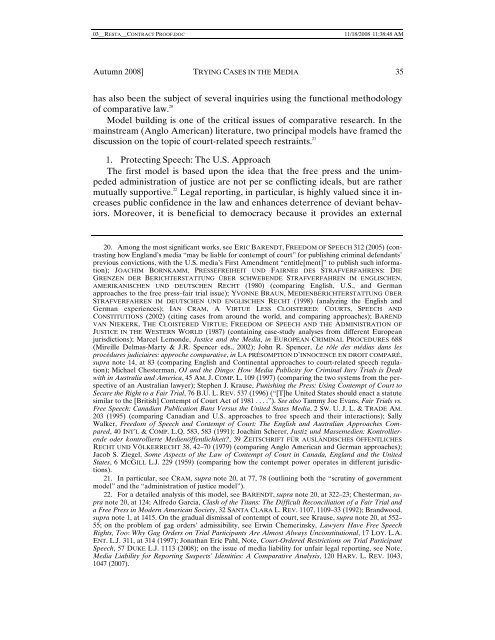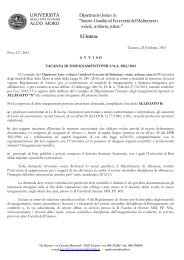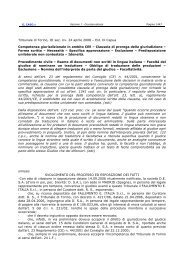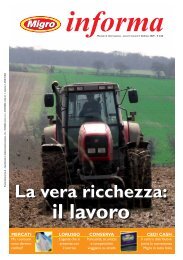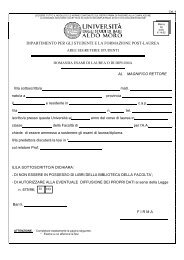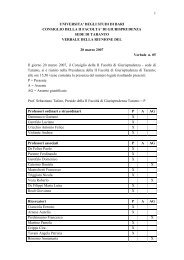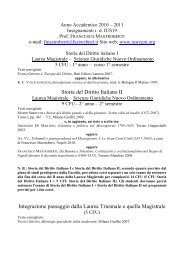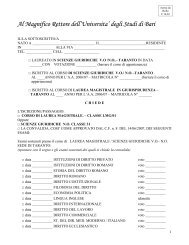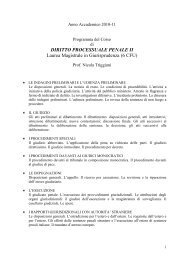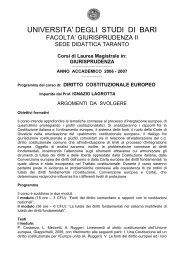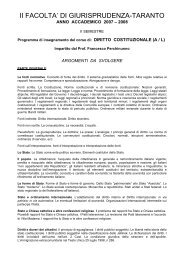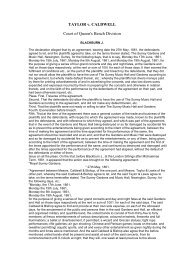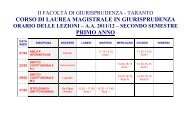TRYING CASES IN THE MEDIA: A COMPARATIVE OVERVIEW
TRYING CASES IN THE MEDIA: A COMPARATIVE OVERVIEW
TRYING CASES IN THE MEDIA: A COMPARATIVE OVERVIEW
You also want an ePaper? Increase the reach of your titles
YUMPU automatically turns print PDFs into web optimized ePapers that Google loves.
03__RESTA__CONTRACT PROOF.DOC11/18/2008 11:38:48 AMAutumn 2008] <strong>TRY<strong>IN</strong>G</strong> <strong>CASES</strong> <strong>IN</strong> <strong>THE</strong> <strong>MEDIA</strong> 35has also been the subject of several inquiries using the functional methodologyof comparative law. 20Model building is one of the critical issues of comparative research. In themainstream (Anglo American) literature, two principal models have framed thediscussion on the topic of court-related speech restraints. 211. Protecting Speech: The U.S. ApproachThe first model is based upon the idea that the free press and the unimpededadministration of justice are not per se conflicting ideals, but are rathermutually supportive. 22 Legal reporting, in particular, is highly valued since it increasespublic confidence in the law and enhances deterrence of deviant behaviors.Moreover, it is beneficial to democracy because it provides an external20. Among the most significant works, see ERIC BARENDT, FREEDOM OF SPEECH 312 (2005) (contrastinghow England’s media “may be liable for contempt of court” for publishing criminal defendants’previous convictions, with the U.S. media’s First Amendment “entitle[ment]” to publish such information);JOACHIM BORNKAMM, PRESSEFREIHEIT UND FAIRNEß DES STRAFVERFAHRENS: DIEGRENZEN DER BERICHTERSTATTUNG ÜBER SCHWEBENDE STRAFVERFAHREN IM ENGLISCHEN,AMERIKANISCHEN UND DEUTSCHEN RECHT (1980) (comparing English, U.S., and Germanapproaches to the free press–fair trial issue); YVONNE BRAUN, MEDIENBERICHTERSTATTUNG ÜBERSTRAFVERFAHREN IM DEUTSCHEN UND ENGLISCHEN RECHT (1998) (analyzing the English andGerman experiences); IAN CRAM, A VIRTUE LESS CLOISTERED: COURTS, SPEECH ANDCONSTITUTIONS (2002) (citing cases from around the world, and comparing approaches); BARENDVAN NIEKERK, <strong>THE</strong> CLOISTERED VIRTUE; FREEDOM OF SPEECH AND <strong>THE</strong> ADM<strong>IN</strong>ISTRATION OFJUSTICE <strong>IN</strong> <strong>THE</strong> WESTERN WORLD (1987) (containing case-study analyses from different Europeanjurisdictions); Marcel Lemonde, Justice and the Media, in EUROPEAN CRIM<strong>IN</strong>AL PROCEDURES 688(Mireille Delmas-Marty & J.R. Spencer eds., 2002); John R. Spencer, Le rôle des médias dans lesprocédures judiciaires: approche comparative, in LA PRÉSOMPTION D’<strong>IN</strong>NOCENCE EN DROIT COMPARÉ,supra note 14, at 83 (comparing English and Continental approaches to court-related speech regulation);Michael Chesterman, OJ and the Dingo: How Media Publicity for Criminal Jury Trials is Dealtwith in Australia and America, 45 AM. J. COMP. L. 109 (1997) (comparing the two systems from the perspectiveof an Australian lawyer); Stephen J. Krause, Punishing the Press: Using Contempt of Court toSecure the Right to a Fair Trial, 76 B.U. L. REV. 537 (1996) (“[T]he United States should enact a statutesimilar to the [British] Contempt of Court Act of 1981 . . . .”). See also Tammy Joe Evans, Fair Trials vs.Free Speech: Canadian Publication Bans Versus the United States Media, 2 SW. U. J. L. & TRADE AM.203 (1995) (comparing Canadian and U.S. approaches to free speech and their interactions); SallyWalker, Freedom of Speech and Contempt of Court: The English and Australian Approaches Compared,40 <strong>IN</strong>T’L & COMP. L.Q. 583, 583 (1991); Joachim Scherer, Justiz und Massemedien: Kontrollierendeoder kontrollierte Medienöffentlichkeit?, 39 ZEITSCHRIFT FÜR AUSLÄNDISCHES ÖFFENTLICHESRECHT UND VÖLKERRECHT 38, 42–70 (1979) (comparing Anglo American and German approaches);Jacob S. Ziegel, Some Aspects of the Law of Contempt of Court in Canada, England and the UnitedStates, 6 MCGILL L.J. 229 (1959) (comparing how the contempt power operates in different jurisdictions).21. In particular, see CRAM, supra note 20, at 77, 78 (outlining both the “scrutiny of governmentmodel” and the “administration of justice model”).22. For a detailed analysis of this model, see BARENDT, supra note 20, at 322–23; Chesterman, supranote 20, at 124; Alfredo Garcia, Clash of the Titans: The Difficult Reconciliation of a Fair Trial anda Free Press in Modern American Society, 32 SANTA CLARA L. REV. 1107, 1109–33 (1992); Brandwood,supra note 1, at 1415. On the gradual dismissal of contempt of court, see Krause, supra note 20, at 552–55; on the problem of gag orders’ admissibility, see Erwin Chemerinsky, Lawyers Have Free SpeechRights, Too: Why Gag Orders on Trial Participants Are Almost Always Unconstitutional, 17 LOY. L.A.ENT. L.J. 311, at 314 (1997); Jonathan Eric Pahl, Note, Court-Ordered Restrictions on Trial ParticipantSpeech, 57 DUKE L.J. 1113 (2008); on the issue of media liability for unfair legal reporting, see Note,Media Liability for Reporting Suspects’ Identities: A Comparative Analysis, 120 HARV. L. REV. 1043,1047 (2007).


